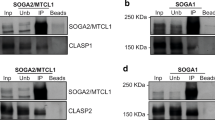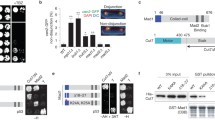Abstract
We have identified a novel Mr 36,000 protein (MSA-36) that has a complex cell cycle dependent distribution. This protein is first detected in interphase nuclei just prior to the onset of chromosome condensation. MSA-36 is found along condensing chromosomes and is a component of the centromere through metaphase. At anaphase, this protein is no longer detected in association with the chromosomes but appears at the forming stembodies and subsequently within the intercellular bridge at either side of the midbody. At the completion of cell division, the amount of MSA-36 in the bridge appears to decline concurrent with the appearance of this protein briefly within the reforming nucleus. To investigate whether MSA-36 is an active component of the chromosome or a passive passenger protein, we studied the behaviour of this protein in cells exhibiting premature chromosome condensation and in cells during and following recovery from mitotic arrest. These studies suggest that MSA-36 is not essential for a variety of major chromosome-associated events.
Similar content being viewed by others
References
Bernat RL, Delannoy MR, Rothfield NF, Earnshaw WC (1991) Disruption of centromere assembly during interphase inhibits kinetochore morphogenesis and function in mitosis. Cell 66:1229–1238
Brenner S, Pepper DA, Turner S, Boyd AE, Brinkley BR (1980) Autoantibodies in human sera selectively bind to the centriole region of cultured cells. J Cell Biol 87:MI 240
Cooke CA, Heck MMS, Earnshaw WC (1987) The inner centromere protein (INCENP) antigens: movement from inner centromere to midbody during mitosis. J Cell Biol 105:2053–2067
Earnshaw WC, Bernat RL (1991) Chromsomal passengers: Towards an integrated view of mitosis. Chromosoma 100:139–146
Earnshaw WC, Cooke CA (1991) Analysis of the distribution of the INCENPs throughout mitosis reveals the existence of a pathway of structural changes in the chromosomes during metaphase and early events in cleavage furrow formation. J Cell Sci 98:443–461
Earnshaw WC, Rothfield N (1985) The identification of a family of human centromere proteins using autoimmune sera from patients with scleroderma. Chromosoma 91:313–321
Gasser SM, Laemmli UK (1987) Improved methods for the isolation of individual and clustered mitotic chromosomes. Exp Cell Res 173:85–93
Hanks SK, Brown DB, Rao PN (1982) Induction of premature chromosome condensation at high frequency following polyethylene glycol-mediated fusion of lectin-bound cells. Exp Cell Res 138:215–219
Harlow E, Lane D (1988) Antibodies: A laboratory manual. Cold Spring Harbor Laboratory Press, NY, p 58
Heneen WK, Rohme D (1982) Spindle formation and chromosome segregation associated with premature chromosome condensation. In: Rao PN, Johnson RT, Sperling K (eds) Premature chromosome condensation: Application in basic, clinical, and mutation research. Academic Press, New York, pp 79–97
Kallajoki M, Weber K, Osborn M (1991) A 210 kDa nuclear matrix protein is a functional part of the mitotic spindle; a microinjection study using SPN monoclonal antibodies. EMBO J 10:3351–3362
Kingwell B, Rattner JB (1987) Mammalian centromere/kinetochore composition: a 50 kDa antigen is present in the mammalian centromere/kinetochore. Chromosoma 95:403–407
Kingwell B, Fritzler MJ, Decoteau J, Rattner JB (1987) Identification and characterization of a protein associated with the stembody using autoimmune sera from patients with systemic sclerosis. Cell Motil Cytoskeleton 8:360–367
Kuriyama R, Keryer G, Borisy G (1984) The mitotic spindle of chinese hamster ovary cells isolated in taxol-containing medium. J Cell Sci 66:265–275
Laemmli UK (1970) Cleavage of structural proteins during the assembly of the bacteriophage head T4. Nature 227:680–685
Lydersen BK, Pettijohn DE (1980) Human-specific nuclear protein that associates with the polar region of the mitotic apparatus: distribution in human/hamster hybrid cells. Cell 22:489–499
McCarty GA, Valencia DW, Fritzler MJ (1984) Antibody to the mitotic spindle apparatus: Immunologic characteristics and cytologic studies. J Rheumatol 11:213–218
Moroi Y, Murata I, Takeuchi A, Kamatini M, Tanimoto K, Yokohari R (1983) Human anticentriole antibodies in patients with scleroderma and Raynaud's phenomena. Clin Immunol Immunopathol 29:381–385
Mullins MJ, McIntosh JR (1982) Isolation and initial characterization of the mammalian midbody. J Cell Biol 94:654–661
Osborn TG, Patel NJ, Ross SC, Bauer NE (1982) Antinuclear antibody staining only centrioles in a patient with scleroderma (letter). N Engl J Med 307(4):253–254
Pankov R, Lemieux M, Hancock R (1990) An antigen located in the kinetochore region in metaphase and on polar microtubule ends in the midbody region in anaphase, characterized using monoclonal antibody. Chromosoma 99:95–101
Price CM, McCarty GA, Pettijohn DE (1984) NuMA protein is a human autoantigen. Anthritis Rheum 27:774–779
Rao PN, Johnson RT (1972) Premature chromosome condensation: A mechanism for the elimination of chromosomes in virus-fused cells. J Cell Sci 10:495–513
Rattner JB (1991) The structure of the mammalian centromere. BioEssays 13:51–56
Rattner JB (1992) Integrating chromosome structure with function. Chromosoma 101:259–264
Rattner JB, Lew J, Wang J (1990) p34cdc2 kinase is present at several distinct domains within the mitotic apparatus. Cell Motil Cytoskeleton 17:227–236
Rattner JB, Martin L, Waisman DM, Johnstone SA, Fritzler MJ (1991) Autoantibodies to the centrosome (centriole) react with determinants present in the glycolytic enzyme enolase. J Immunol 146:2341–2344
Steuer ER, Wordeman L, Schroer TA, Sheetz MP (1990) Localization of cytoplasmic dynein to mitotic spindles and kinetochores. Nature 345:266–268
Tousson A, Zeng C, Brinkley BR, Valdivia MM (1991) Centrophilin: A novel mitotic spindle protein involved in microtubule nucleation. J Cell Biol 112:427–432
Towbin HS, Staehelin S, Gordon J (1987) Electrophoretic transfer of proteins from polyacrylamide gels to nitrocellulose sheets: procedures and some applications. Proc Natl Acad Sci USA 76:4350–4355
Tuffanelli DL, McKeon F, Kleinsmith DA, Burnham TK, Kirshner M (1983) Anticentromere and anticentriole antibodies in the scleroderma spectrum. Arch Dermatol 119:560–563
Wray W, Stubblefield E (1970) A new method for the rapid isolation of chromosomes, mitotic apparatus, or nuclei from mammalian fibroblasts at near neutral pH. Exp Cell Res 59:469–478
Yen TJ, Compton DA, Weis D, Zinkowski RP, Brinkley BR, Earnshaw WC, Cleveland DW (1991) CENP-E, a novel human centromere-associated protein required for progression from metaphase to anaphase. EMBO J 10:1245–1254
Author information
Authors and Affiliations
Additional information
by W.C. Earnshaw
Rights and permissions
About this article
Cite this article
Rattner, J.B., Wang, T., Mack, G. et al. MSA-36: A chromosomal and mitotic spindle-associated protein. Chromosoma 101, 625–633 (1992). https://doi.org/10.1007/BF00360540
Received:
Revised:
Accepted:
Issue Date:
DOI: https://doi.org/10.1007/BF00360540




